Thanks to our special guest contributor Michael Strauss, an Accredited Genealogist from AncestryProGenealogists® for this informative article on military research using military serial numbers.
Understanding the use of serial numbers in the military provides genealogists with a way to discover the branch of service, component assignment, and enlistment date of military personnel. The assigned prefixes give clues to occupational specialties and other work performed. Before service numbers were assigned, military personnel were listed by their name, rank, and military unit designation.
Origins of serial numbers
Serial numbers were first assigned to United States Army enlisted personnel during World War I. On February 12, 1918, the Army issued General Order No. 27, which read: “All soldiers of the United States Army will be numbered by or before February 28, 1918…as soon as a number is assigned to a soldier, it will become a part of his official designation, never changed, never reassigned to another soldier”.
The order further stipulated that the Adjutant General was in charge of issuing the numbers with the American Expeditionary Forces (AEF), noting that “Block numbers will be allotted…to the commanding officers of all organizations of the A.E.F…an accurate account will be kept of numbers allotted and assigned and… excess numbers will be listed”. The same order also noted that the number would be stamped on the soldier’s identification tags and appear conspicuous on the military records, rolls, and reports for the individual. Initially, the numbers were designated to enlisted personnel. The first number was assigned to Master Sergeant Arthur B. Crean (issued number R-1) with his service in the regular United States Army.
The first 310,000 numbers were reserved and then distributed to members of the American Expeditionary Forces (AEF), being sent to France and Belgium. Knowing the serial number will help to determine what component of the AEF a soldier served in. Here is a breakdown of allocations:
1-18,000-Medical Corps
18,000-38,000-Aviation Corps
38,000-105,000-Infantry
105,000-112,000-Machine Gun Battalions
114,000- Headquarter personnel and Military Police (no number range provided)
116,000-122,000-United States Marines (before the branch assigned their own numbers)
123,000-146,000-Field Artillery
146,000-147,000-Trench Mortar personnel
147,000-152,000-Coast Artillery Corps personnel
153,000-154,000-Anti Aircraft personnel
154,000-194,000-Engineers
196,000-197,000-Engineer Trains
197,000-202,000-Signal Corps
203,000-207,000-Ammunition Trains
207,000-208,000-Ordnance personnel
208,000-209,000-Cavalry
212,000-214,000-Supply Trains
215,000-217,000-Motar Supply Trains
217,000-219,000-Quartermaster Corps
219,000-235,000-Stevedores and labor battalions
236,000-General Headquarters of the American Expedition Force
The United States Army understood more personnel would be called up. Additional numbers were issued, starting at 310,001 through 2,380,000, based on where recruits were inducted or later at the military training camps. The camps were separated by regular army, national guard, and national army (for men conscripted), with recruits in the latter two having assigned numbers connected to induction camps. The numbering continued through the end of 1918, reaching 5,999,999. Following the war’s end in 1918, another significant change came in June 1921, when commissioned officers were now issued serial numbers. The first number assigned to an officer (O-1) went to General John J. “Black Jack” Pershing, who commanded the American Expeditionary Forces in France during the war.
The United States Army would continue to use serial numbers through World War II, Korea, and the Vietnam Wars. Some numbers would be issued for very specific groups. The eight million series from 8,000,000-8,999,999 were issued to female enlisted personnel from 1948-1969. Other numbers would be assigned to specific components. The 20 million series from 20,000,000-20,999,999 covered national guardsmen, with the third digitdetermining where the guardsman was from or inducted.
- [20 1]-CT, ME, MA, NH, RI, and VT
- [20 2]-DE, NJ, and NY
- [20 3]-MD, PA, VA, and DC
- [20 4]-AL, FL, GA, MS, NC, SC, and TN
- [20 5]-IN, KY, OH, and WV
- [20 6]-IL, MI, and WI
- [20 7]-CO, IA, KS, MN, MO, NE, ND, SD, and WY
- [20 8]-AR, LA, NM, OK, and TX
- [20 9]-AK, AZ, CA, ID, MT, NV, OR, UT, and WA.
The numbered series would continue to be issued for all components of regular army, national guard, and draftees through 69,999,999, with the last series of ten million issued to draftees for the Vietnam War. The Army didn’t issue numbers in the 70-80 million series but did include limited numbers from 90,000,000 for members of the Philippine Army during World War II. The United States Army also used lettered prefixes attached to serial numbers. During World War I, “R” indicated service in the regular army, “F” was used for field clerks, and “O” for officers. During World War II, other prefixes were added, accounting for personnel assigned to the Woman’s Auxiliary Corps (WACs), warrant officers, and other military occupational specialties issued during the 1950s and 1960s.
Other branches follow
The United States Air Force was formed on September 18, 1947, as a separate military branch due to the passage of the National Security Act of 1947, which restructured the military. The numbers assigned were then divided into series for officers (from 1-3,999,999) and enlisted personnel (from 8,000,000-69,999,999) until 1969. Numbers were broken down with specific date ranges for reservists, air national guard, and personnel who crossed over from the United States Army still on active duty in 1947. The Air Force used prefixes (one and two letters) and suffixes. The prefixes were two-lettered, with the first letter of “F” indicating Air Force. The second letter provided the assigned component. One-lettered suffix codes were assigned to male and female officers, with two letters to other personnel.
The United States Navy began issuing serial numbers by 1920 in a circular from the Department of the Navy. The early numbers were retroactive for active service dating back to 1885 for career sailors who served during the Spanish American War, Philippine Insurrection, and World War I. By the start of World War II, the Navy was regularly issuing enlisted service numbers from the two through nine hundred series. This number now specified a recruiting district code.
For example,872,74,00-874,74-99 would record the inclusive number for Naval Recruiting Station (NRS) in St. Louis, Missouri, which opened on December 15, 1942. The Navy Department book called the Master Service Number Book lists the NRS by serial number and date.
In 1965 the Navy began adding two-lettered prefixes. The “B” series was issued to enlisted personnel covering 10,001-999,999 from 1965-1971. The “D” series was issued covering 10,001-999,999 from 1965-1971.
The United States Navy used prefixes separated into two codes. The first O-Codes (numbered 1-2) were for officers. The second, called V-Codes (numbered 1-12), was for Navy reservists with issued numbers for officers and enlisted personnel.
The United States Marine Corps authorized the assigning of serial numbers as part of their identification on February 15, 1941. They started assigning numbers for all enlisted personnel on March 1, 1941. This change in regulations followed an earlier July 1, 1905, circular that assigned a number to each enlisted case file that was organized numerically. From 1905 to 1941, the numbers were not identification based but created for the purposes of the organization. On May 3, 1950, a memorandum was issued directing the term serial number would be replaced with the term service number until 1972. For commissioned officers, the Marine Corps in the early 1920s started to assign numbers alphabetically, later adding the prefix “O” to distinguish enlisted from officers.
The United States Coast Guard began to record serial numbers for personnel by 1921. The numbers assigned were divided into two different series for officers (from 1-99,999) and enlisted personnel (from 100,000 to 999,999) until 1974. Numbers were broken down with specific date ranges for reservists, warrants, and members of the Coast Guard woman’s Reserve (SPARS) during war and peacetime. The Coast Guard was the only branch not to utilize any form of prefixes.
Moving away from serial numbers
The terms ‘service numbers’ and ‘serial numbers’ are often intertwined. By November 1948, each military branch began to settle on using the term service numbers. Nearly twenty years later, changes occurred in the issuing of numbers. Newspaper reporter Douglas C. Campbell reported on the changes in the Press Democrat in Santa Rosa, California, on May 18, 1969. He wrote, “Old Service Numbers Don’t Die, They Just Fade Away.” The military began moving away from service numbers, and soon each branch began adopting social security numbers.
- United States Army-on 1 July 1969
- United States Air Force-on 1 July 1969
- United States Navy-on 1 January 1972
- United States Marine Corps-on 1 January 1972
- United States Coast Guard-on 1 October 1974
Another change in identification numbers
On June 1, 2011, the branches of the United States military stopped using Social Security Numbers (SSN) to identify service members. The Department of Defense issued a unique ten-digit number that would be used on all forms and records for members of the military.
Searching for records with serial or service numbers
Fold3® has several collections listing serial and service numbers for different branches of the military in the twentieth century. The following collections can prove very helpful in finding that information:
- United States Army Registers, 1798-1969 (after 1921)
Other sources cover the United States Navy, United States Marine Corps, and the Army Air Forces (during World War II) that, after September 15, 1947, would be part of the United States Air Force.
- United States Marine Corps Muster Rolls, 1798-1958 (available on Ancestry®)
This list isn’t exhaustive, and other collections are available on Fold3® and Ancestry® that provide issued numbers for multiple wars and military branches. Digging into your ancestors’ military history and decoding their service numbers will provide valuable clues about our veteran ancestors. These same numbers were soon to be made a permanent part of the identification tags referred to by their colloquial name of “Dog Tags.” In a future blog post, we’ll break down historical details about dog tags.
Did you know you can search Fold3® records by service number? Just use the filter and enter the service number to see records related to your service person.
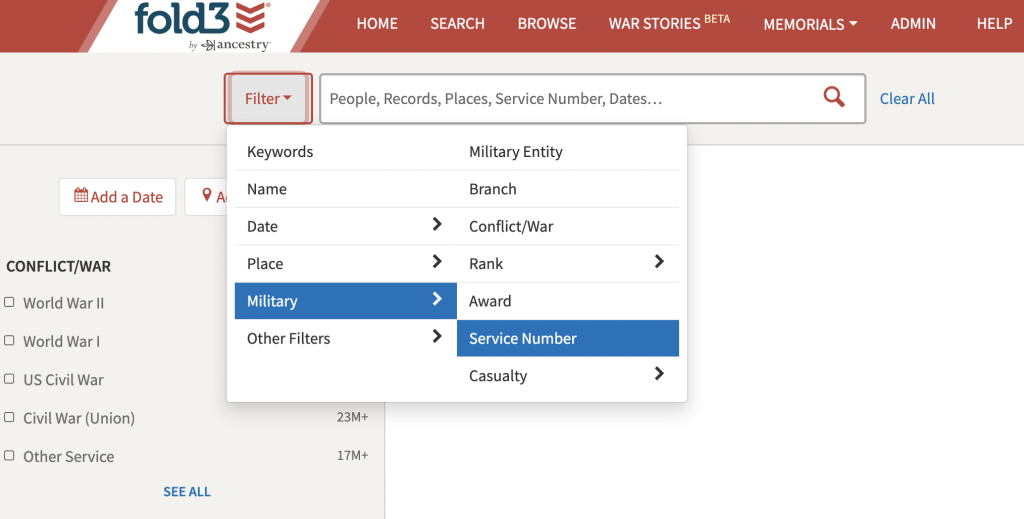
Start searching Fold3® today!
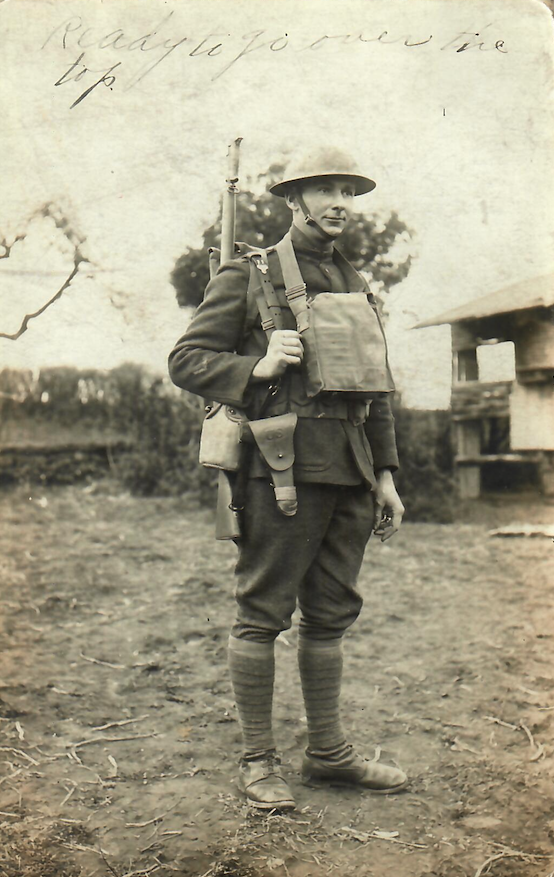
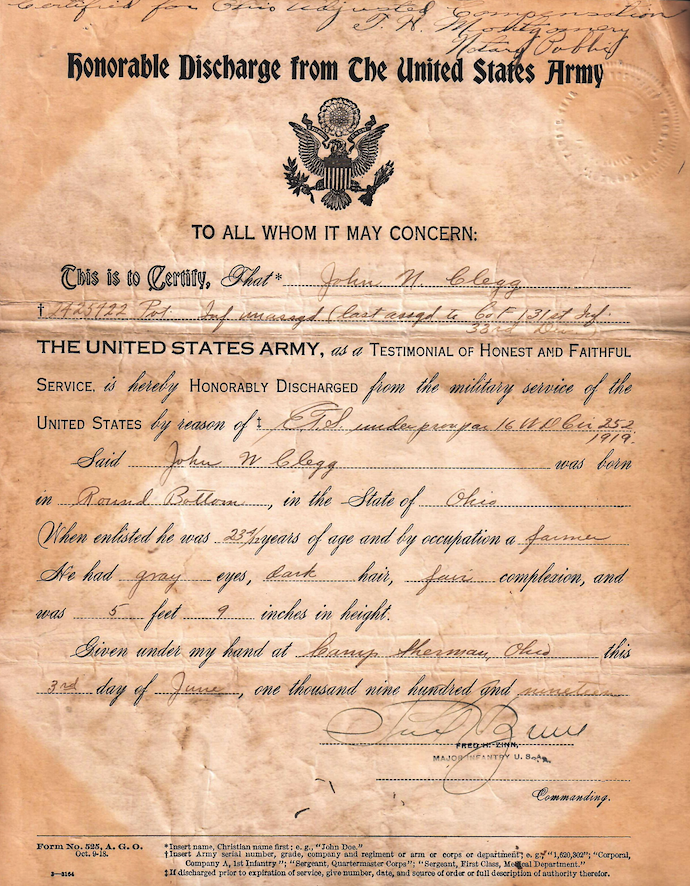
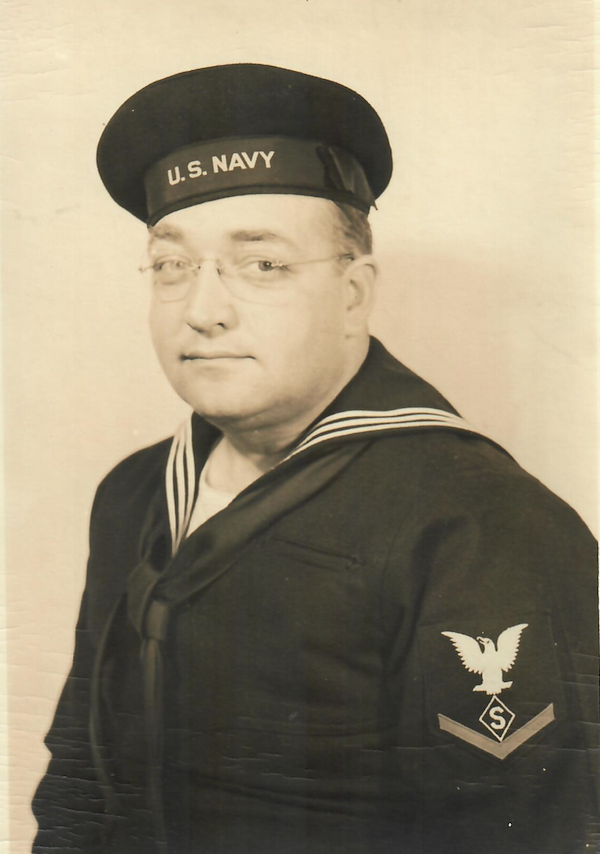
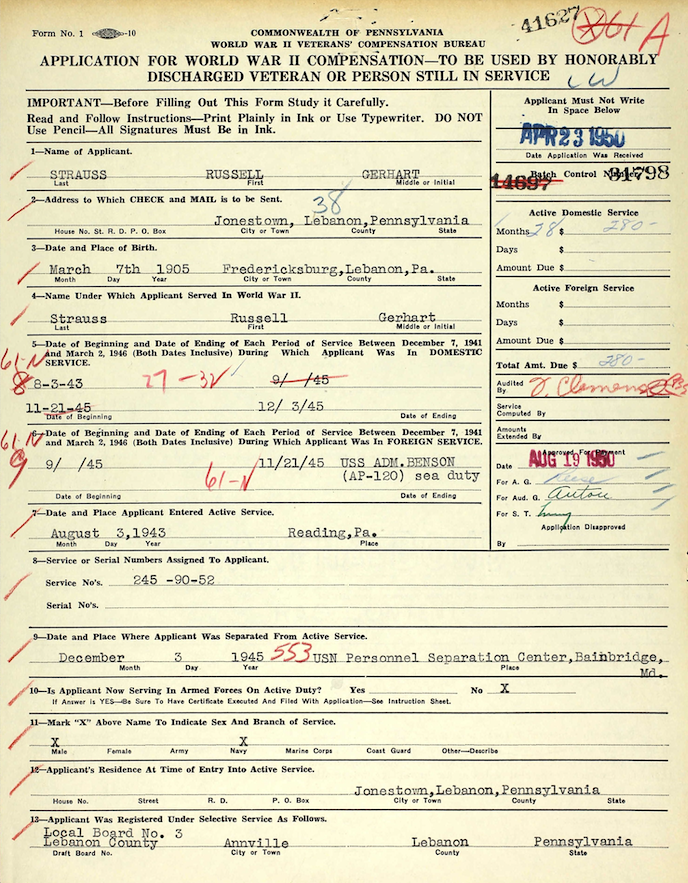
Thank you, Michael. Very interesting stuff. And useful as well when researching men involved in past battles and events.
The Army during Vietnam issues numbers but with Letter prefix’s. Such as RA=Regular Army, NG-National Guard, R=Reserves.
US was used for Draftees.
My Dad was in the 13th Marines in France September 1918, was discharged August 1919. Re-enlisted August 1923. On his Service Record Book from St Louis, he has two serial numbers on the front, 115560 and a note below “AEF Serial No. 292153.” Then he got commissioned late 1941 or 1942 and got, yet another service number. My brother has those records. I researched some of his friends he talked about over the years and they all had serial or service numbers in Haiti and Nicaragua.
Interesting. I have 2 sets of dog tags from my Marine Corps career. First set issued in 1968 have my serial number and the second set has my SSN. I was retired in 1994 so never saw rhe new serial numbers.
Enlisted in USAF on January 7, 1969 and was issued a Service Number. Received my “dog tags” and a laundry stamp and memorized my new identity. I wore the tags as required and identified all my newly issued clothing.
Then, less than two weeks later, still January 1969, I was issued new “dog tags” with my SSN. It was amazing how close the two numbers were. Here I am 54 years later and can still recite my original Service Number.
My grandfather enlisted in the U.S. Army in 1918 as part of the National Army. Your description of the way the U.S. Army issued service numbers says the numbers indicate the camp at which the new soldier was inducted. I believe I know where he was inducted and I have his service number. I would like to compare the service number with a guide to the camps’ allocation of service numbers to make sure I am correct. Does such a guide exist? Could a web link to it be posted to the message field here?
Thank you,
Mark C. Jones
In April 1968, while on R&R in Hawaii, my wife and I were informed that her brother had been killed at Khe Sahn. In cutting orders for my emergency leave, I had to provide my SSN to go along with my serial number which, as John Dorsey said, I can still recite.
I went into the USN in November 1968 and was discharged in November 1972. I still have my original dog tag, which has my service number on it, beginning with a “B”. Later we all changed to our social security number, but I thought it was before 1 January 1972.
Yes- I went in Jan 13, 1967. Discharged Nov 70. Mine too started with a ‘B’ followed by 3 pair of numbers.
According to the National Personnel Records Center, the change over to SSN from SN occurred on the following dates: Which coincides with my experience. I was drafted with a July 2nd, 1969 induction date. I joined on June 29, 1969 prior to the draft induction date of July 2nd, 1969. Thus I have a RA (Regular Army SN) but never used it as by the time I landed in Basic Training, Fort Lewis, WA. they had switched over to using SSN’s.
Branch of Service Date of Changeover
Army and Air Force July 1, 1969
Navy and Marine Corps January 1, 1972
Coast Guard October 1, 1974 https://www.archives.gov/personnel-records-center/social-security-numbers
I was drafted in June 1968, US53581840, and my dog tags had that and the Social Security number. I don’t believe the dumb cluck at DoD that the revealed SSAN number wouldn’t be abused by criminals. Shortly thereafter, the Social Security reference was removed from dog tags. And the VA should use service and serial numbers instead of Social Security Agency Numbers.
What’s really weird is anyone who had one still remembers it I know I do. LOL
There is a hugely misunderstood and mischaracterized “Project 100,000,” specifically draftees who’s Service Number was prefixed US67. In June 1969, over 60,000 individuals were being conscripted per month, even after General Hershey slammed the door shut on minimum educational loads, deferments by occupation, and married with children after a certain date.
I spent Basic Training at Ft Gordon with a group of US67’s from Puerto Rico that were trotted of every day to learn English. I figured out after a while that they weren’t dumb, mentally defective, or socially inadequate. Their biggest problem was Armed Forces Entry Examinations (administered before being sent off to Basic Training) were primarily in English, administered by English speakers. “Don’t sign the paper until I tell you to sign the paper, and your official military signature is your first name, middle initial, and last name.” Don’t have a middle name? You get “X.”